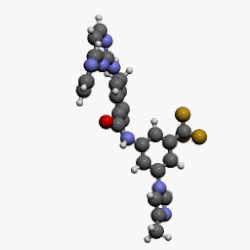 | |
 | |
| Clinical data | |
|---|---|
| Trade names | Tasigna, others |
| Other names | AMN107 |
| AHFS/Drugs.com | Monograph |
| MedlinePlus | a608002 |
| License data | |
| Pregnancy category |
|
| Routes of administration | By mouth |
| Drug class | Antineoplastic |
| ATC code | |
| Legal status | |
| Legal status | |
| Pharmacokinetic data | |
| Bioavailability | 30%[5] |
| Protein binding | 98%[5] |
| Metabolism | Liver (mostly CYP3A4-mediated)[5] |
| Elimination half-life | 15-17 hours[5] |
| Excretion | Faeces (93%)[5] |
| Identifiers | |
| |
| CAS Number | |
| PubChem CID | |
| IUPHAR/BPS | |
| DrugBank | |
| ChemSpider | |
| UNII | |
| KEGG | |
| ChEBI | |
| ChEMBL | |
| PDB ligand | |
| CompTox Dashboard (EPA) | |
| ECHA InfoCard | 100.166.395 |
| Chemical and physical data | |
| Formula | C28H22F3N7O |
| Molar mass | 529.527 g·mol−1 |
| 3D model (JSmol) | |
| |
| |
| | |
Nilotinib, sold under the brand name Tasigna among others, is a anti-cancer medication used to treat chronic myelogenous leukemia (CML) which has the Philadelphia chromosome.[3][6] It may be used both in initial cases of chronic phase CML as well as in accelerated and chronic phase CML that has not responded to imatinib.[3][6][7] It is taken by mouth.[3][7]
Common side effects may include low platelets, low white blood cells, anemia, rashes, vomiting, diarrhea, and joint pains.[7] Other serious side effects may include QT prolongation, sudden death, pancreatitis, and liver problems.[7] It is not safe for use during pregnancy.[7] Nilotinib is a Bcr-Abl tyrosine kinase inhibitor and works by interfering with signalling within the cancer cell.[3][7]
Nilotinib was approved for medical use in the United States in 2007.[3][7] It is on the World Health Organization's List of Essential Medicines.[8] It is approved as a generic medication.[9]
- ^ "FDA-sourced list of all drugs with black box warnings (Use Download Full Results and View Query links.)". nctr-crs.fda.gov. FDA. Retrieved October 22, 2023.
- ^ "Tasigna Summary of Product Characteristics (SmPC)". (emc). October 5, 2023. Archived from the original on March 2, 2024. Retrieved November 13, 2024.
- ^ a b c d e f "Tasigna- nilotinib capsule". DailyMed. February 8, 2024. Retrieved March 9, 2024.
- ^ "Tasigna EPAR". European Medicines Agency (EMA). May 22, 2006. Retrieved August 27, 2024.
- ^ a b c d e Cite error: The named reference
MSRwas invoked but never defined (see the help page). - ^ a b "Nilotinib". National Cancer Institute. February 1, 2008. Archived from the original on July 14, 2021. Retrieved November 14, 2019.
- ^ a b c d e f g "Nilotinib Monograph for Professionals". Drugs.com. Archived from the original on July 14, 2021. Retrieved November 14, 2019.
- ^ World Health Organization (2023). The selection and use of essential medicines 2023: web annex A: World Health Organization model list of essential medicines: 23rd list (2023). Geneva: World Health Organization. hdl:10665/371090. WHO/MHP/HPS/EML/2023.02.
- ^ "First-Time Generic Drug Approvals 2024". U.S. Food and Drug Administration (FDA). March 8, 2024. Archived from the original on January 26, 2021. Retrieved March 9, 2024.